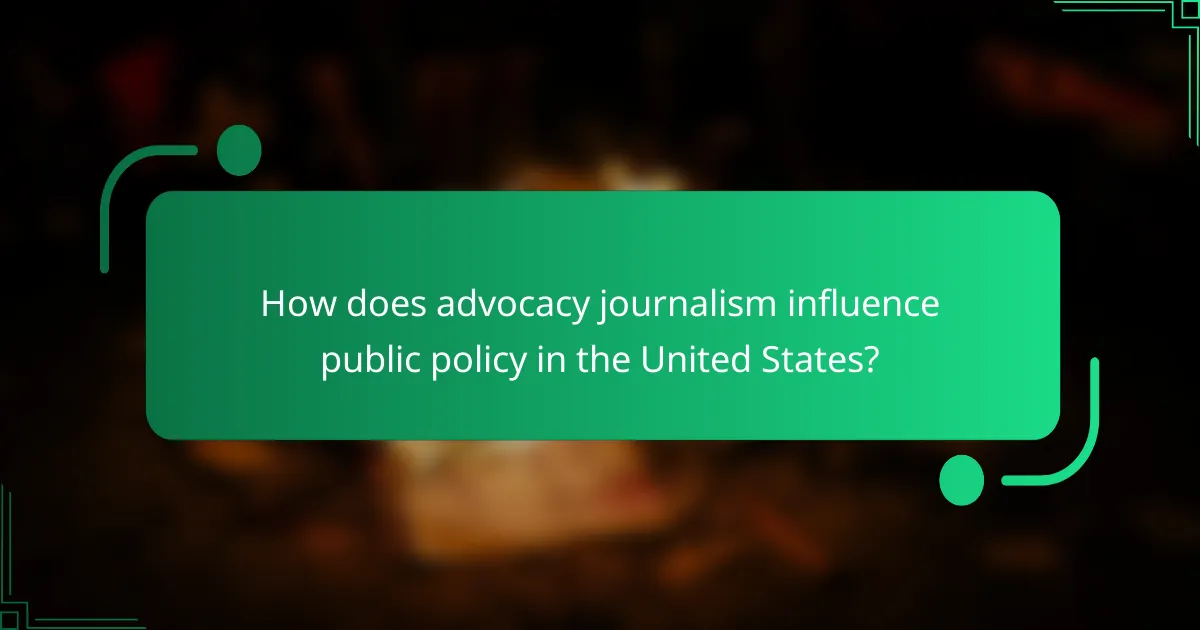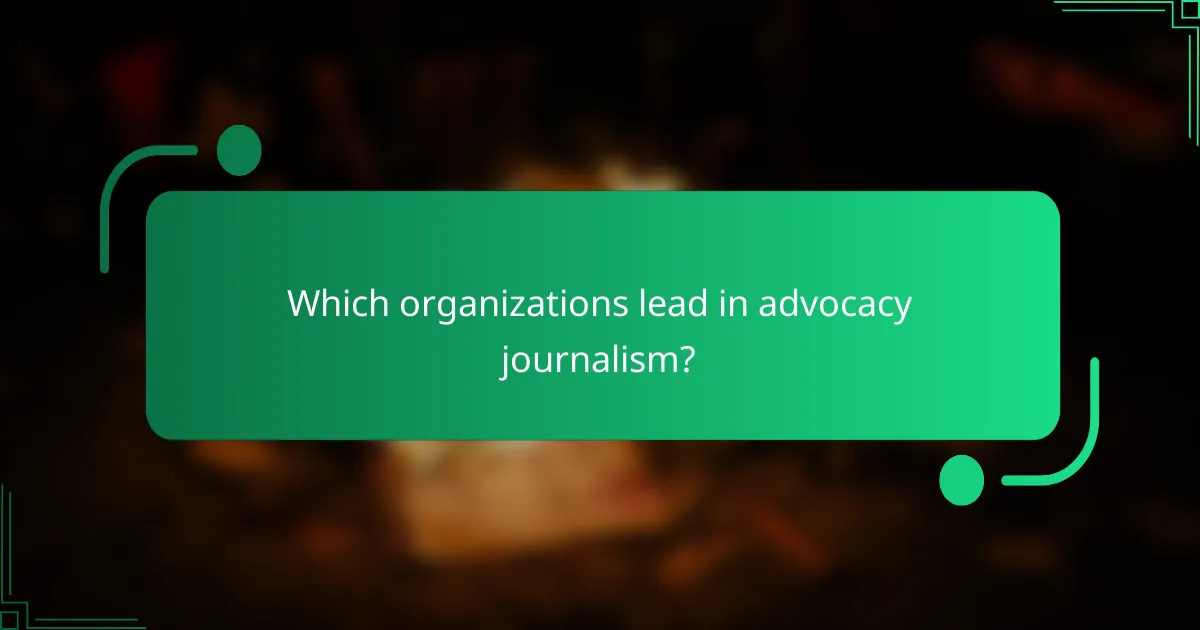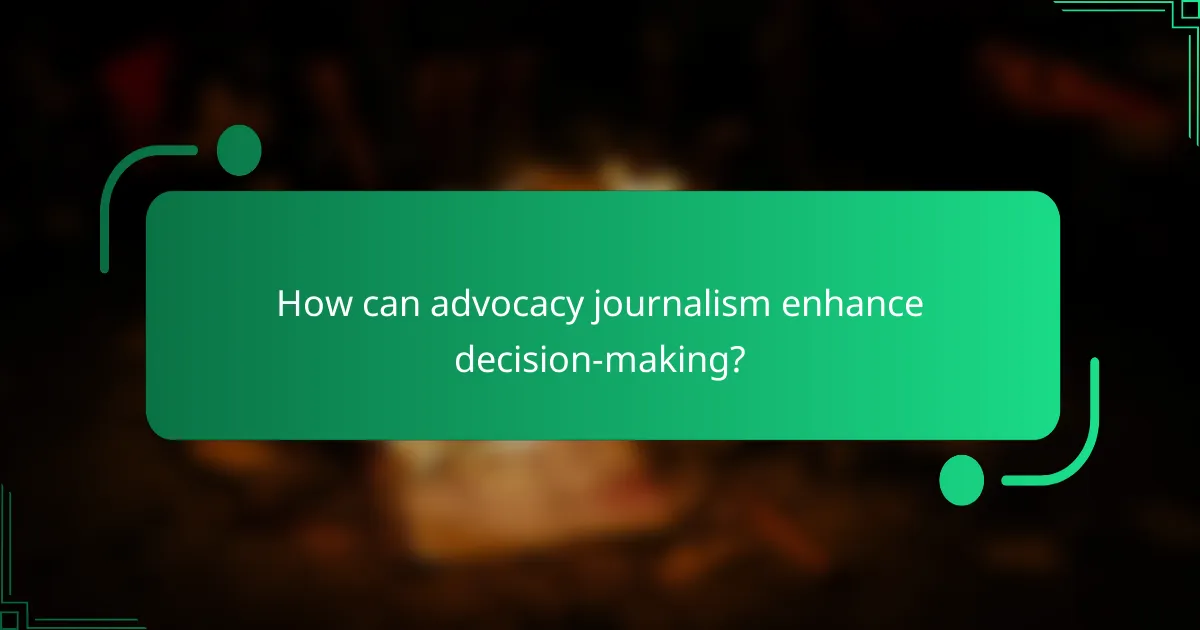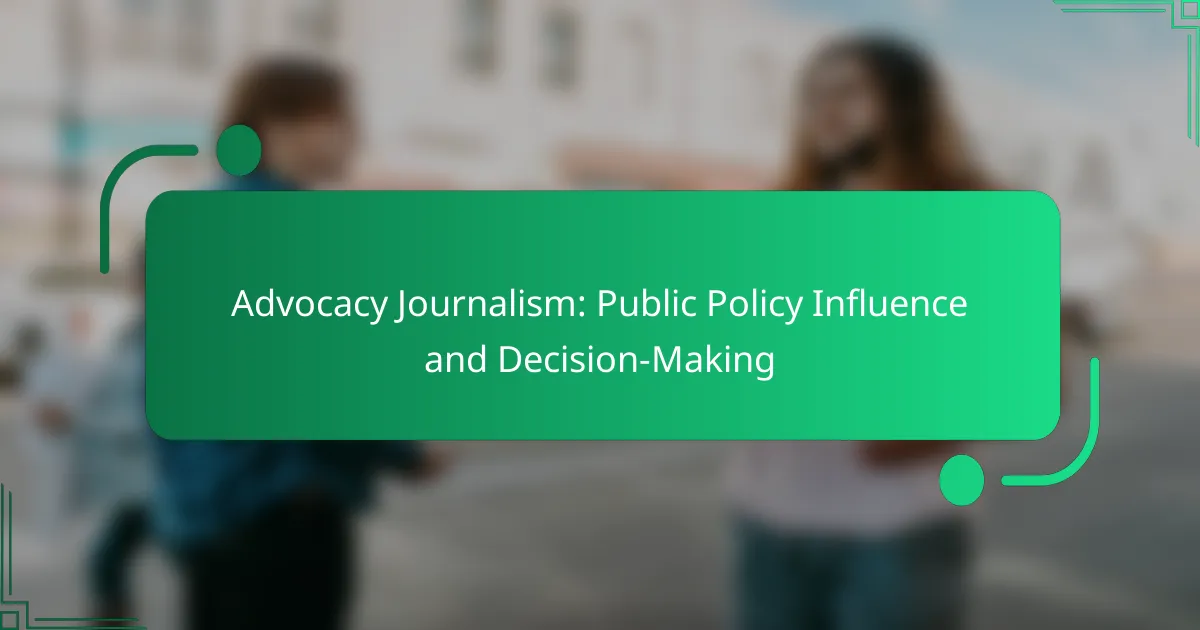Advocacy journalism is essential in influencing public policy and decision-making by raising awareness of critical issues and advocating for marginalized communities. Through investigative reporting and community engagement, journalists not only inform the public but also hold policymakers accountable, driving legislative change. By employing data-driven storytelling and compelling narratives, advocacy journalists effectively shape public opinion and foster civic participation.

How does advocacy journalism influence public policy in the United States?
Advocacy journalism plays a crucial role in shaping public policy in the United States by raising awareness of issues, influencing public opinion, and pushing for legislative changes. Through investigative reporting and storytelling, advocacy journalists highlight the needs of marginalized communities and hold policymakers accountable for their decisions.
Shaping public opinion
Advocacy journalism significantly shapes public opinion by presenting compelling narratives that resonate with audiences. By focusing on specific issues, journalists can sway public sentiment and mobilize citizens to engage in advocacy efforts. This influence is often amplified through social media, where stories can reach a broader audience quickly.
For instance, coverage of climate change has shifted public attitudes, leading to increased support for environmental policies. Advocacy journalists often employ emotional appeals and factual evidence to connect with readers, making complex issues more relatable and urgent.
Highlighting social issues
By bringing attention to social issues, advocacy journalism plays a vital role in identifying problems that may be overlooked by mainstream media. Topics such as racial inequality, healthcare access, and economic disparity are often explored in-depth, providing a platform for voices that are frequently marginalized.
Journalists can use investigative techniques to uncover injustices, such as systemic discrimination or corruption, thereby prompting public discourse and policy discussions. For example, reporting on police brutality has led to widespread protests and calls for reform, demonstrating the power of journalism to spotlight critical social issues.
Driving legislative change
Advocacy journalism can drive legislative change by informing lawmakers and the public about pressing issues that require policy intervention. When journalists expose gaps in legislation or highlight the consequences of inaction, they create pressure for elected officials to respond.
Successful advocacy campaigns often rely on well-researched articles that outline specific policy recommendations. For example, reporting on the effects of healthcare reform can lead to legislative proposals aimed at improving access and affordability. Journalists can also collaborate with advocacy groups to amplify their messages and push for concrete changes in laws and regulations.

What are effective strategies for advocacy journalism?
Effective strategies for advocacy journalism include investigative reporting, community engagement, and data-driven storytelling. These approaches help journalists influence public policy and decision-making by providing in-depth analysis, fostering public participation, and presenting compelling evidence.
Investigative reporting
Investigative reporting is a cornerstone of advocacy journalism, focusing on uncovering hidden truths and exposing injustices. This method often involves extensive research, interviews, and document analysis to reveal issues that may not be immediately visible to the public.
To conduct effective investigative reporting, journalists should prioritize transparency and ethical considerations, ensuring that sources are protected and information is verified. For example, utilizing public records or whistleblower testimonies can strengthen a story’s credibility and impact.
Community engagement
Community engagement involves actively involving the public in the journalistic process, fostering a two-way dialogue between journalists and the communities they serve. This strategy can enhance the relevance of the reporting and empower citizens to advocate for their interests.
Journalists can engage communities through town hall meetings, social media platforms, and collaborative projects. For instance, hosting workshops to educate citizens about local issues can help build trust and encourage participation in advocacy efforts.
Data-driven storytelling
Data-driven storytelling leverages quantitative evidence to support narratives and highlight trends that may influence public policy. By using statistics and data visualization, journalists can present complex information in a digestible format that resonates with audiences.
When employing this strategy, it’s essential to ensure data accuracy and relevance. Journalists should consider using local datasets to illustrate issues that directly affect their communities, such as crime rates or public health statistics, making the information more relatable and actionable for readers.

Which organizations lead in advocacy journalism?
Several organizations are at the forefront of advocacy journalism, focusing on public policy influence and decision-making. These entities aim to hold power accountable through investigative reporting and in-depth analysis of critical issues.
ProPublica
ProPublica is a nonprofit newsroom dedicated to investigative journalism that serves the public interest. It produces in-depth reports on various topics, including government accountability, healthcare, and environmental issues, often revealing systemic problems that require policy changes.
By utilizing a collaborative approach, ProPublica partners with local news organizations to amplify its impact. This strategy not only enhances the reach of its stories but also fosters community engagement around key issues.
The Center for Investigative Reporting
The Center for Investigative Reporting (CIR) is known for its commitment to uncovering stories that matter. It focuses on issues such as social justice, public health, and government transparency, often employing multimedia storytelling to engage a wider audience.
CIR’s flagship project, Reveal, combines investigative reporting with a podcast format, making complex topics accessible. This innovative approach helps to inform public discourse and encourages civic participation in policy matters.
Mother Jones
Mother Jones is a nonprofit news organization that combines investigative journalism with a progressive perspective. It covers a range of topics, including politics, climate change, and economic inequality, aiming to influence public policy through its reporting.
With a strong emphasis on accountability, Mother Jones often highlights stories that challenge the status quo and advocate for change. Its investigative pieces are designed to provoke thought and inspire action among its readership, making it a significant player in advocacy journalism.

What role do digital platforms play in advocacy journalism?
Digital platforms are crucial in advocacy journalism as they amplify voices, facilitate engagement, and enable fundraising. They provide tools for journalists and organizations to reach wider audiences and influence public policy effectively.
Social media outreach
Social media is a powerful tool for advocacy journalism, allowing journalists to share stories and engage with audiences in real-time. Platforms like Twitter, Facebook, and Instagram enable the rapid dissemination of information and foster community discussions around critical issues.
To maximize impact, advocacy journalists should tailor their content to each platform’s unique audience and features. For instance, using eye-catching visuals on Instagram can enhance engagement, while concise, impactful messages work well on Twitter.
Online fundraising
Digital platforms facilitate online fundraising, which is essential for sustaining advocacy journalism efforts. Crowdfunding sites and social media campaigns allow journalists and organizations to gather financial support directly from their audience.
Effective online fundraising strategies include creating compelling narratives around specific projects, offering incentives for donations, and leveraging social media to promote fundraising efforts. Clear calls to action and transparency about fund allocation can significantly increase donor trust and contributions.
Audience engagement metrics
Understanding audience engagement metrics is vital for advocacy journalism as it helps measure the effectiveness of outreach efforts. Metrics such as shares, comments, and likes provide insights into what content resonates with the audience.
Advocacy journalists should regularly analyze these metrics to refine their strategies. Tools like Google Analytics and social media insights can help track engagement trends, allowing for data-driven decisions that enhance future content and outreach initiatives.

How can advocacy journalism enhance decision-making?
Advocacy journalism enhances decision-making by providing critical information that influences public policy and governance. It empowers citizens and policymakers with evidence-based insights, promotes transparency, and encourages meaningful public dialogue.
Providing evidence-based insights
Advocacy journalism delivers well-researched information that supports informed decision-making. By presenting data, case studies, and expert opinions, it helps stakeholders understand complex issues and the potential impact of various policies. For example, a report on climate change might include statistics on rising temperatures and their effects on agriculture.
To maximize the effectiveness of these insights, journalists should ensure that their sources are credible and diverse. Utilizing a mix of academic research, expert interviews, and real-world examples can create a more compelling narrative that resonates with both the public and decision-makers.
Encouraging transparency
Transparency is crucial for effective governance, and advocacy journalism plays a key role in promoting it. By investigating and reporting on government actions, funding allocations, and policy decisions, journalists hold public officials accountable. This scrutiny can deter corruption and encourage ethical behavior among policymakers.
For instance, investigative pieces that reveal discrepancies in public spending can prompt audits and reforms. Journalists should focus on clear, accessible reporting that highlights the implications of opaque practices, ensuring that the public remains informed and engaged.
Fostering public dialogue
Advocacy journalism fosters public dialogue by creating platforms for discussion and debate on important issues. By featuring diverse voices and perspectives, it encourages community engagement and helps shape public opinion. This dialogue can lead to more inclusive policy-making processes that reflect the needs of various constituencies.
To enhance public discourse, journalists can organize forums, publish opinion pieces, and utilize social media to facilitate conversations. Engaging with the audience through Q&A sessions or polls can also provide valuable feedback that informs future reporting and advocacy efforts.

What are the challenges faced by advocacy journalists?
Advocacy journalists encounter several significant challenges that can hinder their ability to influence public policy and decision-making. These include funding limitations, political pressure, and the need to maintain journalistic integrity while pushing for specific causes.
Funding limitations
Funding limitations are a major hurdle for advocacy journalists, as they often rely on grants, donations, or sponsorships to support their work. This financial dependency can lead to potential conflicts of interest or biases in reporting, as funders may have specific agendas.
Many advocacy journalism projects operate on tight budgets, which can restrict the scope of their investigations and outreach efforts. For instance, a small nonprofit may only have enough resources to cover local issues, limiting their impact compared to larger organizations with broader funding.
Political pressure
Political pressure is another significant challenge for advocacy journalists, who may face threats or intimidation from powerful entities that oppose their viewpoints. This pressure can come from government officials, corporations, or even public backlash, making it difficult to report freely.
To navigate political pressure, advocacy journalists must develop strong networks and support systems. Building alliances with other media organizations, civil society groups, and legal experts can provide protection and amplify their voices in the face of opposition.
